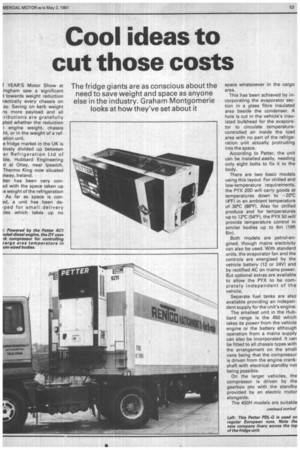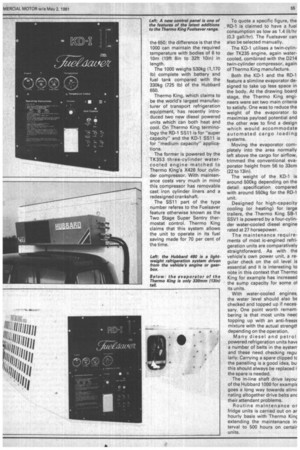Cool ideas to cut those costs
Page 63

Page 64

Page 65

If you've noticed an error in this article please click here to report it so we can fix it.
The fridge giants are as conscious about the need to save weight and space as anyone else in the industry. Graham Montgomerie looks at how they've set about it
YEAR'S Motor Show at ingham saw a significant I towards weight reduction ractically every chassis on ay. Saving on kerb weight ns more payload and all :ributions are gratefully pted whether the reduction -1 engine weight, chassis ht, or in the weight of a refation unit.
e fridge market in the UK is tively divided up between or Refrigeration Ltd of ble, Hubbard Engineering d at Otley, near Ipswich, Thermo King now situated 3Iway, Ireland.
tter has been very conad with the space taken up le weight of the refrigeration As far as space is coned, a unit has been deiped for small delivery les which takes up no space whatsoever in the cargo area.
This has been achieved by incorporating the evaporator section in a glass fibre insulated area beside the condenser. A hole is cut in the vehicle's insu lated bulkhead for the evapora tor to circulate temperaturecontrolled air inside the load area with no part of the refrigeration unit actually protruding into the space.
According to Petter, the unit can be installed easily, needing only eight bolts to fix it to the body.
There are two basic models using this layout. For chilled and low-temperature requirements, the PYX 20D will carry goods at temperatures down to —20°C (4°F) in an ambient temperature of 30°C (86°F). Also for chilled produce and for temperatures up to 12°C (54°F), the PYX 50 will provide temperature control in similar bodies up to 6m (19ft 8in).
Both models are petrol-engined, though mains electricity can also be used. With standard units, the evaporator fan and the controls are energised by the vehicle battery (12 or 24V) and by rectified AC on mains power. But optional extras are available to allow the PYX to be completely independent of the vehicle.
Separate fuel tanks are also available providing an indepen dent supply for the unit's engine.
The smallest unit in the Hubbard range is the 450 which takes its power from the vehicle engine or the battery although operation from a mains supply can also be incorporated. It can be fitted to all chassis types with the arrangement on the small vans being that the compressor is driven from the engine crankshaft with electrical standby not being possible.
On the larger vehicles, the compressor is driven by the gearbox pto with the standby provided by an electric motor alongside.
The 450H models are suitable for chilled products down to 3°C (37°F), while the L version is for frozen products dOwn to —18°C (0°F).
The power absorbed by the compressor is two to three horse power, while the weight of a 450 unit is 100kg (220 lb) without electric standby and 150 kg (330 lb) with it.
Moving up the range, the 475 is a bulkhead-mounted unit suitable for body lengths of up to 4.9m (16ft) when used for frozen products or up to 6.7m (22ft) for chilled contents. The unit mounts onto the front of the vehicle body with the evaporator section inserted into the refrigerated space. The compressor is vehicle-driven either from a gearbox mounted pto or direct from the crankshaft pulley.
The standard temperature range of the Hubbard 475 is between —18°C (0°F) and 7°C (45°F), though alternative thermostats are available for the temperature control between 30°C (23°F) or 0°C (32°F) and 15°C 59°C The 475 is provided with two operator controls. A selector switch has two positions — Truck and Standby — which enables the driver to choose vehicle power or mains electric operation. A manual defrost button is provided on low-temperature models in addition to the fully automatic system.
The average weight of a 475 is around 75kg (164 lb) or 125kg (274 lb) depending on whether the electric standby is specified.
For small and medium n delivery vehicles, Hubbard markets the 480. This is a lightweight system which can be driven from the engine or gearbox and from a mains electric supply.
The condensing section is mounted on the front bulkhead but there are two evaporators available: the standard is most suitable for shelved vehicles where the shelving runs right up to the front bulkhead while the slimline is a wall or ceiling mounted unit.
Subject to operating conditions, the 480 is for body lengths up to 4.5m (14ft 9in) for frozen goods and up to 6.0m (19ft Bin) for chilled products. The standard set point range for the thermostat is —20°C (-4°F) to 5°C (41T), though alternative ranges are available.
According to Hubbard the complete 480 system, installed, weighs approximately 175kg (385 lb).
For the 650 and 1000 refrigera tion units from Hubbard, diesel power is used with the former, the diesel engine is a single-cylinder air-cooled unit from rivals Petter which develops six horsepower. In conjunction with a fuel tank, 12v battery and alternator, the 650 can operate inde pendently of the vehicle.
The unit has a temperature controller with a scale range of —40°C ( —40°F) to 40°C (104°F).
Hubbard claims that the thermostat will maintain the present
temperature to within 11/2°C.
The 650 employs a transverse arrangement of diesel engineelectric motor compressor with the condenser mounted on one end of the unit. The whole unit is sound insulated to the extent that claims a maximum noise level of 72dBA at 7m (23ft). Hubbard intends the 650 tc used for insulated bodies medium or large vehicles trailers) in the 5 to 9m (16ft 5ir 29ft 6in) range depending on dividual application.
At the top end of the Hubb range is the 1000 which ag uses Petters power; in this c the twin-cylinder air-cooled engine which delivers just o ten horsepower. As with the E the in-line shaft drive layou: used which, Hubbard clair gives minimum noise level In high performance and reliabil One of the main advantage: this layout, of course, is tha eliminates most of the dr belts normally used in refrigE tion units.
The temperature range for Hubbard 1000 is the same as the 650; the difference is that the 1000 can maintain the required temperature with bodies of 6 to 10m (19ft 8in to 32ft 10in) in length.
The 1000 weighs 530kg (1,170 lb) complete with battery and fuel tank compared with the 330kg (725 lb) of the Hubbard 650.
Thermo King, which claims to be the world's largest manufacturer of transport refrigeration equipment, has recently introduced two new diesel powered units which can both heat and cool. On Thermo King terminology the RD-1 SS11 is for "super capacity" and the KD-1 SS11 is for "medium capacity" applications.
The former is powered by the TK353 three-cylinder watercooled engine matched to Thermo King's X426 four cylinder compressor. With maintenance costs very much in mind this compressor has removable cast iron cylinder liners and a redesigned crankshaft.
The SS11 part of the type number referes to the Fuelsaver feature otherwise known as the Two Stage Super Sentry thermostat control. Thermo King claims that this system allows the unit to operate in its fuel saving made for 70 per cent of the time. To quote a specific figure, the RD-1 is claimed to have a fuel consumption as low as 1.4 lit/hr (0.3 gall/hr). The Fuelsaver can also be selected manually.
The KD-1 utilises a twin-cylinder TK235 engine, again water cooled, combined with the D214 twin-cylinder compressor, again of Thermo King manufacture.
Both the KD-1 and the RD-1 feature a slimline evaporator de signed to take up less space in the body. At the drawing board stage, the Thermo King engi neers were set two main criteria to satisfy. One was to reduce the weight of the evaporator to maximise payload potential and the other was to find a design which would accommodate automated cargo loading systems.
Moving the evaporator completely into the area normally left above the cargo for airflow, trimmed the conventional evaporator height from 56 to 33cm (22 to 13in).
The weight of the KD-1 is around 500kg depending on the detail specification compared with around 550kg for the RD-1 unit.
Designed for high-capacity cooling (or heating) for large trailers, the Thermo King SB-1 SSV1 is powered by a four-cylinder water-cooled diesel engine rated at 27 horsepower.
The maintenance requirements of most ic-engined refri geration units are comparatively straightforward. As with the vehicle's own power unit, a re gular check on the oil level is essential and it is interesting to note in this context that Thermo King for example has increased the sump capacity for some of its units.
With water-cooled engines, the water level should also be checked and topped up if neces sary. One point worth remem• bering is that most units neec topping up with an anti-freezE mixture with the actual strengif depending on the operation. Many diesel and petrol powered refrigeration units have a number of belts in the systerr
and these need checking regu larly. Carrying a spare clipped tc the panelling is a good idea, bu. this should always be replaced i the spare is needed.
The in-line shaft drive layou. of the Hubbard 1000 for example
goes a long way towards elimi nating altogether drive belts anc their attendant problems.
Routine maintenance or fridge units is carried out on ar
hourly basis with Thermo Kinc. extending the maintenance in terval to 500 hours on certair units.
















































































































